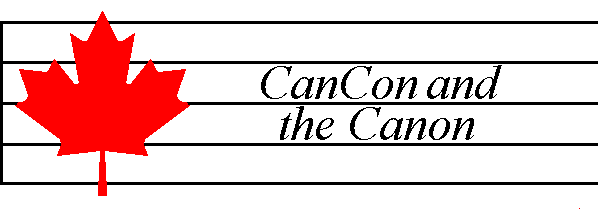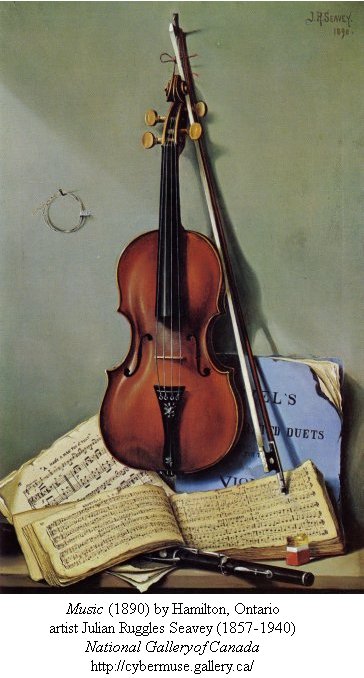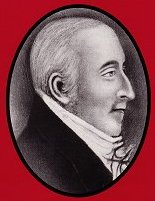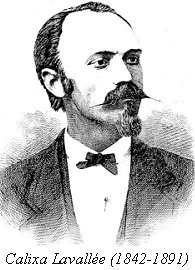


This web page is devoted to providing simple ways of including Canadian content in general music history survey courses. It is inspired in part by a similar project that is devoted to including American materials in music history survey courses. That project is called Bringing Music History Home: A Guide for American Teachers of Music History, and is available as a web site here.
The present web page is an outgrowth of my article "CanCon and the Canon," Revue de musique des universités canadiennes / Canadian University Music Review 23/1-2 (2003): 201-13. Feedback in the form of comments, criticisms, and suggestions for additional material is most welcome. Further information about many of the topics listed below can be found in the online edition of the Encyclopedia of Music in Canada. Robin Elliott
Marius Barbeau was convinced that the origins of the Quebec folksong repertory that he collected, studied, and transcribed lay with the jongleurs of medieval France. Barbeau also fostered the performance of medieval and Renaissance music in Canada, for instance at the Canadian Folk Song and Handicraft Festival held in Quebec City in 1927.
The voyages of exploration that brought Europeans to Canada were a product of the Renaissance era: Jacques Cartier and Claudin de Sermisy were contemporaries. Centuries later, the music of Healey Willan often takes its inspiration from Renaissance vocal music.
A 540-page manuscript of French Baroque organ music was rediscovered in 1979 and has been titled Le livre d’orgue de Montréal. It has been the subject of extensive research by Élisabeth Gallat-Morin. Kenneth Gilbert has recorded a 2-CD set of excerpts from the manuscript for the Analekta label. The research of Gallat-Morin, Erich Schwandt, Jean-Pierre Pinson, and others has shed much light on the nature of music making in the colony of New France (1608-1759); the lifespan of this colony coincided closely with the dates of the Baroque era in European music.

There was a lively music scene in late-eighteenth and early-nineteenth-century Halifax and Quebec City, with performances of works by European composers such as Haydn, Mozart, and Pleyel soon after they were composed. Joseph Quesnel (pictured right) wrote two works of music theatre that have been revived in modern times: Colas et Colinette (premiered in Montreal in January 1790, the same month that Così fan tutte was premiered in Vienna) and Lucas et Cécile (possibly not performed before the twentieth century). As Lucien Poirier has pointed out, Colas et Colinette was strongly influenced by Jean-Jacques Rousseau's Le Devin du village. You can listen to the Overture to Colas et Colinette (composed in 1964 by Godfrey Ridout; the original, if there was one, has been lost) here.
Two items of Mozart trivia: a substitute aria for Così fan tutte, 'Rivolgete a lui lo sguardo,' includes the phrase 'che gli uguali non si trovano da Vienna al Canada' ('whose like you will not find from Vienna to Canada'); and Mozart, Saskatchewan may be the only town in the world named after that composer.
T.F. Molt, a native of Stuttgart who settled in Quebec in 1822, visited Beethoven in 1825; this was Beethoven's only known contact with the New World. Beethoven wrote a canon for Molt, 'Freu dich des Lebens,' (WoO 195), which has been the subject of compositions by various Canadian composers (including Alexander Brott, Patrick Cardy, Eldon Rathburn, Clifford Ford, Gilles Leclerc, and Jan Jarvlepp). For further information and audio samples, see the web site of the CBC Radio program Music Around Us. Incidentally, Ludwig Johann van Beethoven, the son of Beethoven’s nephew Karl, lived in Toronto and Montreal briefly from 1872 to 1873 (see the article by Kallmann listed below).

Calixa Lavallée studied in Paris from 1873 to 1875 with Marmontel, who was also Debussy's teacher at the time. Though best-known today for having written the Canadian national antherm ('O Canada'), Lavallée wrote a good deal of instrumental and vocal music. His piano etude Le Papillon, Op. 18 is a moto perpetuo study somewhat similar to Chopin’s Minute Waltz. It appeared in over 20 different editions in North America and Europe, and is available for download in PDF and MIDI file formats here. The music of Lavallée, and many other 19th and early 20th-century Canadian composers, is available in the 25 volumes of music published by the Canadian Musical Heritage Society. A selection of materials is available for downloading from Canada's Digital Collections here.
Several prominent European musicians of the 19th century visited Canada. Some, such as Tchaikovsky, only set foot in the country briefly (at Niagara Falls), while others settled in Canada and contributed to the growth of music in the country. Franz Liszt, though he did not set foot in Canada, did have numerous contacts with the country, and his pupil Waugh Lauder actively promoted the music of Liszt and Wagner in Canada via numerous lecture-recitals.
Visits from prominent composers and musicians from abroad proliferated during the course of the 20th century. Ravel visited Vancouver, Toronto, and Montreal in 1928 and gave recitals of his music. Stravinsky first visited Toronto in 1937 and returned for conducting and recording sessions on six occasions in the 1960s. Britten also lived in Canada briefly in 1939, and his orchestral work Canadian Carnival, Op. 19, quotes various fiddle tunes and folksongs from Quebec. Messiaen visited Canada on four occasions, and included numerous Canadians among his pupils. The influence of Boulez on Canada is the subject of an entire issue (3.1, 1992) of the periodical Circuit - Boulez au Canada: Portrait d'impact.
